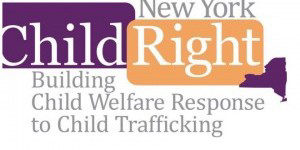ChildRight: Building Child Welfare Response to Child Trafficking
Implemented from 2013-2016 with support from the New York State Office for Children and Family Services
Child victims of sex or labor trafficking are often isolated, separated from a safe family structure, or already living on their own. Child welfare agencies play a critical role in the prevention, identification, and response to child trafficking because of their direct involvement with vulnerable youth. In many states, legislation demands that child welfare agencies be equipped to address the needs of trafficked children and youth. In reality, most child welfare agencies lack the training, skills, tools, and resources to properly screen, identify, and serve this population.
Recognizing the need for a comprehensive, long-term strategy for state child welfare agencies to address child trafficking, including the commercial sexual exploitation of children (CSEC) and labor trafficking, the International Organization for Adolescents (IOFA) and the Center for Human Rights of Children at Loyola University Chicago (CHRC) created ChildRight. The ChildRight New York project, initiated in 2013 with support from New York State’s Office of Children & Family Services (OCFS), is a comprehensive, multi-pronged intervention designed to build child welfare response to child trafficking statewide.
The Model
The goals of ChildRight are to identify and address systemic gaps in knowledge, behavior, policies, and procedures in child welfare systems and to enable state and local child welfare agencies to screen, identify, and respond effectively to the needs of children and youth trafficked for sex and/or labor. ChildRight’s objectives are:
Increase the number of trafficked children and youth that are properly identified in the United States;
Improve the capacity of child welfare agencies to identify, assess, refer, and/or provide specialized services to trafficked children and youth; and,
Ensure a coordinated and comprehensive statewide response to child trafficking by building consensus and fostering collaboration across multiple sectors.
Outcomes & Accomplishments
The first phase of the project, which concluded in March 2014, reached 975 child welfare professionals across the state through training and over 60 key stakeholders through participation in the statewide Blueprint steering committee and subcommittees. The project also provided technical assistance to 27 agencies in the five project pilot counties of Erie, Onondaga, Monroe, Westchester, and New York City. A statewide Blueprint and operational framework was drafted and presented to OCFS in March 2014 for further development in Phase II (April 2014 to March 2015).
In Phase II, IOFA completed ChildRight trainings in three additional NY counties–Nassau, Suffolk, and St. Regis–and second requested trainings in Erie County and New York City. These trainings reached over 600 local service providers and direct service staff. Over the next three months, IOFA staff will work closely with OCFS on drafting and clearing the Blueprint/Operational Framework and accompanying resource handbook, in addition to training OCFS’s Division of Juvenile Justice and Opportunities for Youth and State Central Registry, and Child Advocacy Centers. IOFA is also working on adapting the training to a web-based format, developing screening tools, and evaluating broader project outcomes.
Nineteen minors were confirmed between September 1, 2013 and September 2014 under the process created by New York’s 2007 anti-trafficking law. All of these minors were referred for confirmation by a ChildRight New York pilot area. Only 37 minors had been confirmed as trafficking victims in the previous five years that the state law was in effect. Thus, the rate of identification of trafficked youth in New York since ChildRight New York’s implementation has increased by 51%.
Eighty-eight partners from the eight pilot regions continue to convene monthly to exchange ideas, share best practices, and stay updated on the latest anti-trafficking activities in New York State. Partner agencies in the eight pilot regions have developed and are now implementing customized action plans to identify and provide appropriate services to potentially trafficked children and youth. IOFA continues to provide technical assistance to assist partners in sustaining their efforts.
Past Projects
[insert page=’past-projects’ display=’content’]